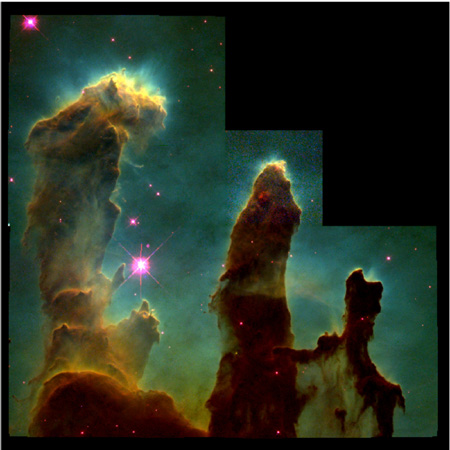 An interesting article in the 30 October New Scientist discusses a new theory on how the solar system began. A team from the Arizona State University led by astronomer Jeff Hester argued last May in Science that isotopic evidence and accumulated astronomical observations argue for a violent, energetic region near high-mass stars as the birthplace of our system.
An interesting article in the 30 October New Scientist discusses a new theory on how the solar system began. A team from the Arizona State University led by astronomer Jeff Hester argued last May in Science that isotopic evidence and accumulated astronomical observations argue for a violent, energetic region near high-mass stars as the birthplace of our system.
Image: The Eagle Nebula, as photographed by the Hubble Space Telescope. This famous photo, often known as “The Pillars of Creation,” shows giant nebular clouds being evaporated by the ferocious energy of massive stars, exposing emerging solar systems, much like our own. Credit: NASA/HST/Jeff Hester and Paul Scowen
Forming near a massive, unstable star would have had interesting implications for the appearance of habitable planets. From an ASU press release:
The process leaves a Sun-like star and its surrounding disk sitting in the interior of a low density cavity with a massive star close at hand. Massive stars die young, exploding in violent events called “supernovas.” When a supernova explodes it peppers surrounding infant planetary systems with newly synthesized chemical elements – including short-lived radioactive isotopes such as iron-60.
Hester and company argue that a nearby supernova could have profoundly influenced the habitability of the Earth. Thus planetary habitability may be tied to the interstellar environment that gave birth to particular stars.
From the New Scientist article:
Hester believes it should be possible to look at star-forming regions with massive stars and simply count the number of embryonic stars at a distance from massive stars that would allow them to retain some water and form Earth-like planets.
And citing Alan Boss of the Carnegie Institution (who first proposed that the solar system formed in a region of high-mass stars), the article continues:
Suddenly the search for extraterrestrial life is looking a lot more optimistic. We know that around 90 percent of stars form in regions of high-mass star formation. “If that is where the solar system formed, then the chances of there being planetary systems similar to our own jump by a factor of about 10 compared to the alternative,” Boss says. That makes it 10 times more likely that we’ll find a habitable planet in the neighborhood.
Sources: J. Jeff Hester, Steven J. Desch, et al. “The Cradle of the Solar System.” Science Vol. 304 (21 May 2004): 1116-1117. Marcus Chown, “Hell’s Nursery,” New Scientist 30 October 2004, pp. 61-64. Press release from Arizona State University.

